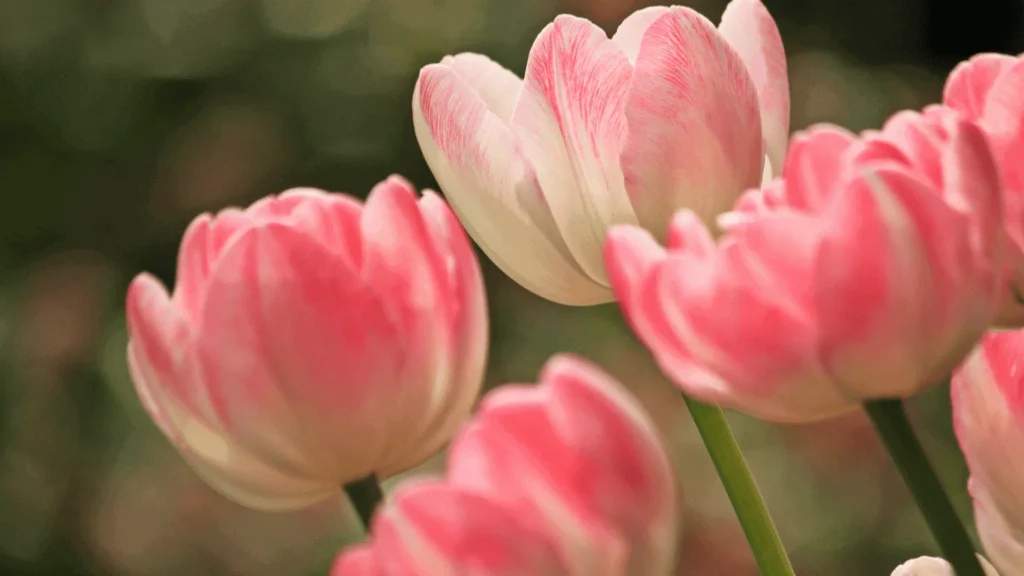When to Plant Tulip Bulbs in NC

As Wake Forest’s premier landscaping company, the residential landscaping experts at Turf TitanZ are committed to enhancing the natural beauty of our community, one garden at a time.
Tulips, with their vibrant hues and elegant forms, are a favorite among garden enthusiasts for good reason. These exquisite spring flowers not only bring a burst of color to your landscape but also symbolize the arrival of a new season and the promise of warmer days ahead.
That’s why our garden professionals are taking a deep dive into the world of tulips, offering expert advice on selecting the right varieties along with planting and caring for them. Whether you’re a seasoned gardener or just starting your green journey, join us as we explore when to plant tulip bulbs in NC. Let’s transform your Wake Forest garden into a tapestry of vibrant spring flowering bulbs.
Why Choose Tulips?
Tulips, with their timeless charm and breathtaking beauty, have earned a special place in the hearts of gardeners around the world. Let’s explore why choosing tulips for your Wake Forest landscape is sure to satisfy with their vibrancy and artistry.
Colors, Shapes, and Varieties
When tulip bulbs are planted in your garden bed for spring growth, you can improve the appearance of your lawn. Tulip plant bulbs come in a breathtaking array of colors; from bold and fiery reds to soft pastels and everything in between, tulips offer a kaleidoscope of hues that can be tailored to your style and garden’s theme. When tulips bloom into their elegant and diverse shapes, from classic cup-shaped blossoms to fringed and parrot tulips, they add an extra layer of intrigue to your landscape.
Low Maintenance
When you plant spring flowering bulbs like tulips, they require minimal upkeep, making them a low-maintenance plant for your garden. Along with daffodil bulbs, tulips are known for their ease of care, making them an excellent choice for busy homeowners. With a few easy, simple steps, you can keep your tulips flowering and flourishing with minimal effort, allowing you to enjoy their beauty without the stress of a demanding maintenance schedule.
Versatility in Garden Design
Whether you have a small urban garden or a sprawling estate, planting the fertilizing bulbs of tulips creates a visually pleasing atmosphere that fits any landscape. When planting bulbs of tulips in your garden, they add versatility to the other grasses, plants, shrubs, and greenery. From formal flowerbeds to naturalistic meadows, both small and large bulbs of tulips grow in a way that can be integrated seamlessly into various garden styles.
Preparing Your Wake Forest Garden for Tulip Planting
As spring approaches, it’s time to start thinking about adding vibrant splashes of color to your Wake Forest garden with tulips. These elegant flowers not only bring beauty but also signify the arrival of a new season.
However, before you plant the bulbs for your tulips, it’s crucial to lay the groundwork for success. Our tulip planting experts are walking you through the essential steps to ensure your garden is ready to plant tulips that will flourish into beautiful spring blooms.
Testing Soil pH Levels
Before diving into tulip planting, it’s crucial to understand the condition of your soil. Conducting a soil test will provide valuable insights into soil pH levels and nutrient content. While there are DIY soil testing kits on the market, a local lawn care company can offer an affordable soil test with reliable results.
The soil test results will help you determine if any amendments are needed to create the ideal growing conditions for tulips. Typically, tulips prefer well-drained soil with a pH level between 6.0 and 7.0.
Choosing a Planting Area
Selecting the right planting area to grow tulips is crucial for the success of your garden. Look for a spot in your garden that receives full sun or light shade. Most bulbs of tulips thrive in sunlight but can also tolerate some shade, especially in warmer climates.
Additionally, consider the aesthetic aspect when choosing a planting area. Tulips are lovely flowers that look stunning when planted in clusters or along garden borders. Take into account the height and color of the tulip varieties you plan to plant to create visually appealing arrangements.
Ensuring Proper Drainage
Proper drainage is essential for the health of tulip bulbs. Soggy or waterlogged soil can lead to rot and other diseases, jeopardizing the success of your garden. To improve drainage conditions, avoid planting tulip bulbs in low-lying areas or areas prone to water accumulation.
If your soil has poor drainage, you can improve it by amending the soil with organic material such as compost or peat moss. This organic matter helps loosen compacted soil and improves its ability to drain excess water. Additionally, consider raised beds or container gardening for areas with persistent drainage issues.
Selecting the Right Tulip Varieties
North Carolina has a temperate climate with distinct seasons, including relatively mild winters and warm springs.
Here are some tulip varieties that tend to perform well in North Carolina’s climate:
- Darwin Hybrid Tulips: These tulips are known for their strong, sturdy stems and large, classic tulip-shaped flowers. They offer a wide range of colors, including vibrant reds and yellows, and are well-suited to the state’s climate.
- Triumph Tulips: Triumph tulips are versatile and perform well in various climates. They come in a wide range of colors and are known for their strong stems and medium-sized blooms.
- Fringed Tulips: Fringed tulips, with their delicate, fringed petal edges, can add a touch of elegance to your NC garden.
- Single Early Tulips: Single early tulips are among the first to bloom in spring and can handle cooler temperatures. Varieties like Red Emperor and Apricot Beauty provide early-season color and adapt well to North Carolina’s conditions.
- Species Tulips: Some species tulips are well-suited to North Carolina’s climate. They are smaller in size and have a natural, less formal appearance.
- Botanical Tulips: Botanical tulips are excellent choices for naturalizing in North Carolina gardens. They have a more relaxed, wildflower appearance and are well-suited to rock gardens and containers for tulips in pots.

The Best Tulip Planting Time for North Carolina Landscapes
Tulips are a symbol of spring, bringing vibrant colors and a sense of renewal to gardens across North Carolina. Whether you’re a seasoned gardener or just starting out, knowing the best time to plant tulips in this region is essential for a successful and stunning display. In North Carolina, where climates can vary from the mountains to the coast, understanding the optimal planting window ensures that your tulips thrive.
Timing for Planting Tulips
In North Carolina, the best time to plant tulips is typically late fall, ideally between late October and early December. Planting during this period allows the new bulbs to establish their root systems before the onset of the winter chilling period.
Consideration of Climate Zones
North Carolina encompasses several USDA hardiness zones, ranging from zone 6 in the mountains to zone 8 along the coast. It’s crucial to consider your local climate zone when determining the optimal planting time for tulips.
For instance, gardeners in the cooler mountain regions may opt to plant tulips slightly earlier in the fall to ensure adequate chilling hours for the bulbs, while those in warmer coastal areas may plant them in late winter to avoid premature sprouting.
Monitoring Soil Temperature
Tulip cultivars require a period of cold dormancy to stimulate growth and flowering. In regions with milder winters, monitoring soil temperature can help determine the best time to plant. Aim to plant tulip bulbs when the soil temperature has cooled to around 55°F or lower, typically occurring in late fall.
Preparing for Frost
While North Carolina experiences relatively mild winters compared to northern states, frost can still occur, especially in higher elevations and inland areas. When planting tulips, be prepared to protect the young shoots from potential frost damage. Mulching the soil surface can help insulate the bulbs and provide some protection against frost. Additionally, covering newly planted bulbs with a layer of straw or frost cloth during cold snaps can safeguard them until warmer temperatures return in early to late spring.
How to Care for Tulips
Once your tulip bulbs are in the ground, proper care is essential to ensure they thrive and produce the stunning spring blooms you desire.
Watering Your Tulips
Proper watering is crucial for the health and growth of tulips. When initially planting tulip bulbs, it’s essential to water them thoroughly to settle the soil and initiate root growth. The soil should be evenly moist but not waterlogged during this stage. Once tulips have emerged and established their foliage, maintaining a regular watering schedule is important, particularly during dry spells or when the soil becomes noticeably dry.
Typically, aiming for about 1 inch of water per week, whether from rainfall or supplemental watering, is a good guideline. However, it’s important to exercise caution to avoid overwatering, as tulips prefer well-draining soil. Allowing the soil to dry slightly between watering sessions helps prevent issues like bulb rot.
Fertilizing Tulips
Fertilizing tulips is an important aspect of their care to promote healthy growth and vibrant blooms. The best time to fertilize tulips is in the fall, when you plant the bulbs. Use a slow-release, balanced fertilizer with equal or near-equal amounts of nitrogen, phosphorus, and potassium. Incorporate the fertilizer into the soil at the planting depth, following package instructions for the appropriate amount.
Pest and Disease Management
Pest and disease management is crucial for maintaining the health and beauty of tulips. Common pests that may affect tulips include aphids, slugs, and bulb mites. To manage these pests, regularly inspect your tulip plants for signs of infestation and take appropriate action.
Diseases like tulip fire and tulip mosaic virus can also impact tulips. Proper cultural practices, such as planting tulips in well-draining soil, providing adequate spacing, and avoiding overhead watering, can help reduce the risk of fungal diseases like tulip fire.
Choose Our Wake Forest Landscaping Professionals for Flowers, Plants, Shrubs, and More
Whether you’re looking to plant vibrant flowers like tulips, add lush greenery with a variety of plants, or create a picturesque scene with carefully selected shrubs, our team of landscape design experts is here to bring your garden dreams to life. With our expertise and commitment to quality, your outdoor space will flourish like never before.
Don’t wait—contact Turf TitanZ today and let us transform your Wake Forest property into a botanical masterpiece. Get started by calling us at (919) 562-0771 or by filling out the contact form below.
